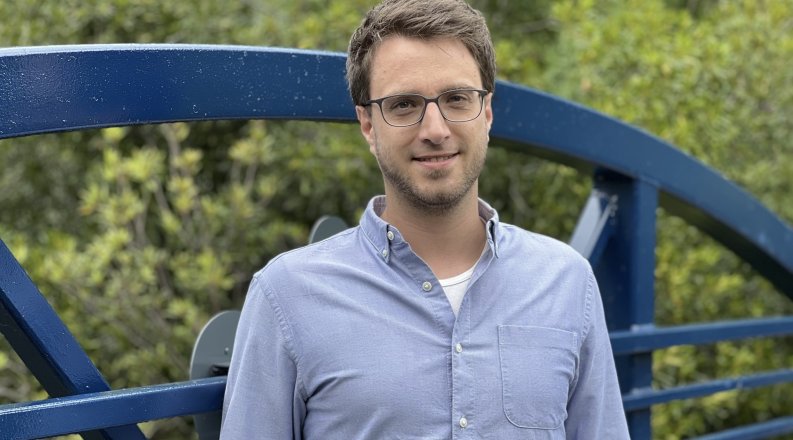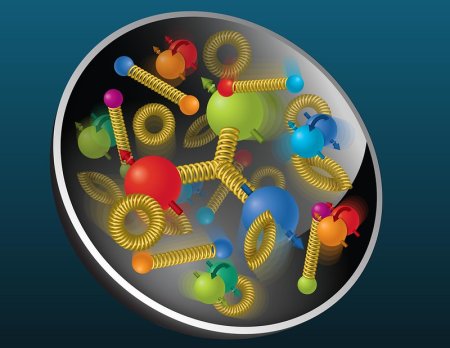By Tiffany L. Whitfield and Victoria Bourne
In the beginning, there were quarks and gluons.
According to the Department of Energy, a soupy plasma of these elementary particles permeated the entire universe until fractions of a second after the Big Bang. They were then frozen together as protons and neutrons once things cooled.
Despite being the fundamental building blocks of matter, many unanswered questions about them remain, according to Old Dominion University physicist Felix Ringer — much of that due to the limitations of classical computing and ability to interpret vast amounts of data. That mystery is part of their appeal.
“There's no more substructure that we're aware of; as far as we know, these are elementary particles,” said Ringer, whose research centers around theoretical nuclear and particle physics. “And so of course, one of the motivations (of studying them) is to see is there yet more than that.”
The unique properties and interactions of quarks and gluons can be studied in detail at collider experiments where they are produced at high energies, such as those conducted at the Continuous Electron Beam Accelerator at the Thomas Jefferson National Accelerator Facility (Jefferson Lab) in Newport News.
“We know what we have is in principle inconsistent at higher energies, but we don't know exactly where,” Ringer said. “At some point, we know our theories will break down. We try to do very precise measurements and very precise theory (and) experiment comparisons to see does it agree or is there some tension? Or do we see some unusual signals that can tell us more?”
Ringer is an assistant professor of physics with a joint appointment at Jefferson Lab. Prior to coming to ODU in 2022, he earned master's degrees from the University of Cambridge, England and the University of Tübingen in his native Germany, where he also got his Ph.D.
He has conducted postdoctoral research at Los Alamos and Lawrence Berkeley national laboratories in New Mexico and California, respectively, as well as at the University of California, Berkeley. He was a project scientist at Berkeley Lab and a Simons Foundation Bridge Fellow at Stony Brook University in New York.
At ODU, he teaches upper undergraduate courses like thermodynamics and statistical mechanics and
mathematical methods of physics.
(Image courtesy of Brookhaven National Laboratory's photo stream)
Ringer, 37, recently received the distinguished Early Career Research Award from the U.S. Department of Energy (DOE). He was one of 93 experts from across the country to receive the honor, which was created in 2010 to help support “exceptional researchers at the outset of their careers, when many scientists do their most formative work,” according to a DOE press release. The grants totaled $135 million dollars, and Ringer received a five-year grant for $875,000. The money will be used to fund ODU graduate and postdoctoral students as well as to purchase computing resources.
He joins two other ODU physicists who won the award: Ted Rogers, who got it 2017; and Raúl Briceño, now at the University of California, Berkeley, awarded in 2018.
“The continued success of our young faculty in nuclear and particle theory in competing for these awards is a testament to the high caliber of faculty we are able to attract to our department, in part thanks to our close collaboration with Jefferson Lab,” said Sebastian Kuhn, chair and professor at ODU’s Department of Physics.
“His research in theoretical nuclear physics is particularly important to the scientific program planned for the future Electron Ion Collider,” said Gail Dodge, dean of ODU’s College of Sciences. The 2.4-mile-circumference world-class particle collider being designed at the DOE’s Brookhaven National Laboratory could see experiments starting around 2030.
Ringer’s grant-winning proposal is titled “Toward a microscopic picture of hadronization and multi-parton processes.”
“With this funding award from DOE, I will focus in particular on the intriguing question of why quarks and gluons are never found in isolation in the natural world; instead, they are always grouped together within particles like protons, neutrons and pions,” Ringer said.
Quarks, which can have a positive or negative electric charge, entered the theoretical scene in 1964, and evidence of their existence was revealed in 1968 experiments conducted at the Stanford Linear Accelerator Center in California, according to the DOE website.
Gluons were discovered in 1979 through experiments at Germany’s Deutsches Elektronen-Synchrotron laboratory. Much like their name suggests, gluons act as the super glue that binds quarks together. The interaction between quarks and gluons is responsible for almost all the perceived mass of protons and neutrons, according to the DOE. They are inextricably linked – neither can exist as free particles, and neither can exist without the other, according to Space.com.
Despite extensive research, a microscopic picture of the process that leads to their confinement – or hadronization – has remained elusive, according to Ringer, and a limited understanding of the multiple interactions between quarks and gluons that occur in high-energy particle collisions has become a research bottleneck.
Addressing this is one of the main frontiers of the U.S. nuclear physics program. He said advancements in quantum computing, which allows researchers to do calculations much faster than classical computing, and artificial intelligence, which can help evaluate broad swaths of data, as well as the DOE’s new Electron Ion Collider could introduce the next generation of theory and experimentation.
The stage is set for potential future discoveries, Ringer said, adding the next 10 to 15 years could reveal new insights to unanswered questions. Others may yet remain just out of reach – at least in his lifetime.
“I think it makes it a very exciting time because these are the new tools that we'll have at our disposal,” he said. “We're trying to see how far they can take us.”
Fast Facts about Quarks & Gluons
- There are six kinds of quarks - named up, down, charm, strange, top and bottom - with a wide range of masses; the last and heaviest was first observed at Fermi National Accelerator Laboratory (Fermilab) near Chicago in 1995.
- Quarks are the only elementary particles to experience all known forces of nature and to have a fractional electric charge.
- The force that holds quarks together, carried by the gluons, is the strongest force in nature – conveniently called “strong force.”
- Unlike the other fundamental forces – gravity, weak and electromagnetic – that get weaker with distance, the farther you try to pull quarks apart, the stronger the gluon-generated strong force binds them.
Sources: DOE Explains, CERN and Space.com




